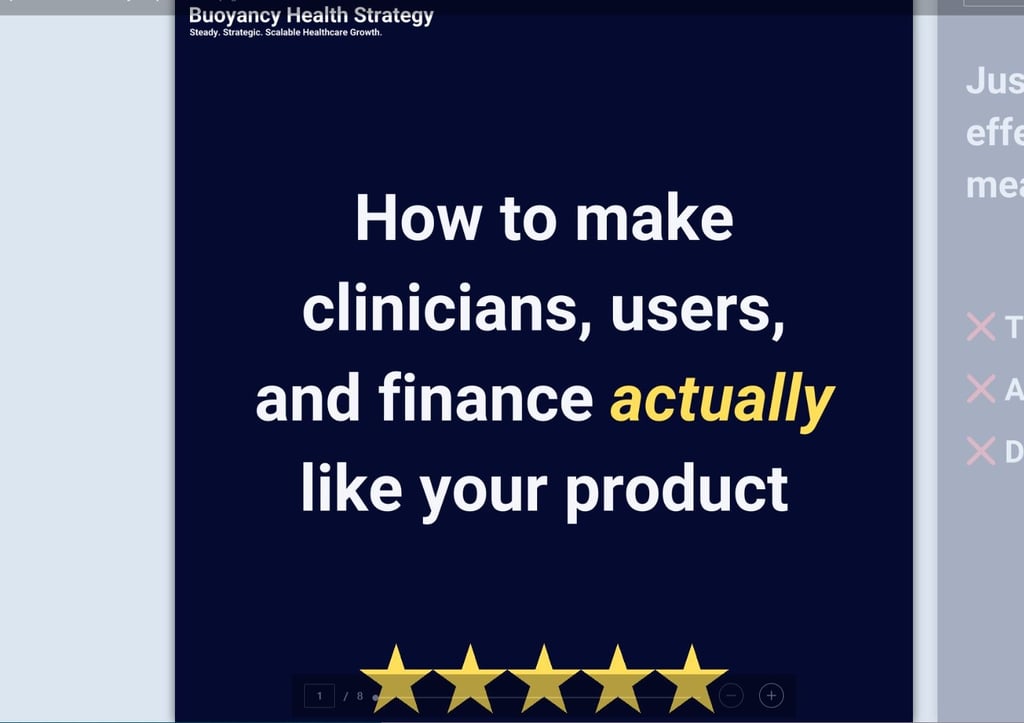How to make clinicians, users, and finance actually like your product
Matthias Winker
2/27/20253 min read


Getting market access for a pharmaceutical or medical device in the UK (and for most countries) is tough. You need regulatory approval, reimbursement, and a rock-solid health economics case.
But here’s the thing—none of that guarantees that clinicians will actually want to use your product or that patients will stick with it (We know that medicine adherence is low and 30-50% of all prescribed medicines for long-term conditions are not taken as recommended).
A product can be clinically brilliant, cost-effective, and NICE-approved, but if it doesn’t fit into a clinician’s workflow or make a real difference to a patient’s life, it’s going to gather dust.
So how do you make your product not just available, but wanted?
1️⃣ Solve a problem that actually matters
The NHS is stretched thin and clinicians are overloaded (no news story here). If your product adds even a small layer of complexity, they won’t use it—no matter how good the clinical data looks.
Ask yourself:
✅ Does this fit into existing workflows?
✅ Does it save time, reduce admin, or make a clinician’s job easier?
✅ Does it solve a problem in a way that’s actually practical?
Example: A new digital tool that requires extra data entry? Hard pass. A tool that integrates seamlessly into the EHR? Now we’re talking.
2️⃣ Bring clinicians on the journey
You can’t just show up with a finished product and expect buy-in. Clinicians trust their peers and value real-world evidence over marketing claims.
🔹 Get early feedback—before you even go to market.
🔹 Involve KOLs to champion your product.
🔹 Run pilot programs so NHS teams can see real benefits in action.
Example: A medtech company that co-develops with NHS clinicians will have a much easier time with adoption than one that just “drops in” a solution.
3️⃣ Make it stupidly simple to use
Even the best innovations fail if they’re hard to adopt. Clinicians are time-poor, and patients won’t engage with something that’s confusing or clunky.
🔹 Minimise the learning curve—the less training needed, the better.
🔹 Reduce cognitive load—automate what can be automated.
🔹 Make instructions fool proof—both for clinicians and patients.
Example: A complex medical device that requires a 30-minute setup? That’s going to struggle. One that’s plug-and-play? Much better.
4️⃣ Make it an easy ‘Yes’ for procurement teams
Even if clinicians love your product, it still needs to pass the NHS procurement hurdle. That means you need to speak their language:
🔹 Cost-effectiveness: How does this save money for the NHS?
🔹 Alignment with NHS priorities: Does it support prevention, digital health, or efficiency?
🔹 Reimbursement clarity: Is it on formulary, and does it fit into NICE guidelines?
Example: A therapy that reduces hospital admissions will fly through budget discussions faster than one with benefits that only show up years down the line.
5️⃣ Get patients on your side
Patients are becoming more vocal in treatment decisions. If they don’t like your product, clinicians will hear about it. Or if they do, clinicians will hear about it too.
🔹 Engage patient advocacy groups early.
🔹 Make sure it’s accessible—easy to use, with clear instructions.
🔹 Use real patient stories to show impact.
Example: A wearable device that’s comfortable and discreet will have much better long-term adherence than one that’s bulky and awkward.
Bottom Line: Adoption = Market Success
Regulatory approval and reimbursement are just the first steps. The real test is whether clinicians and patients (and carers) actually want to use your product.
So before you focus on how to sell it, focus on how to make them want and like it:
✔ Solve a problem that actually matters
✔ Get clinicians involved early
✔ Prioritise ease of use
✔ Align with NHS procurement goals
✔ Win patient trust
Nail these, and you won’t just have a product that’s approved—you’ll have a product that’s used.
First published on LinkedIn
Buoyancy Health Strategy
Steady. Strategic. Scalable Healthcare Growth
© 2025 Buoyancy Health Strategy Ltd. All rights reserved.
